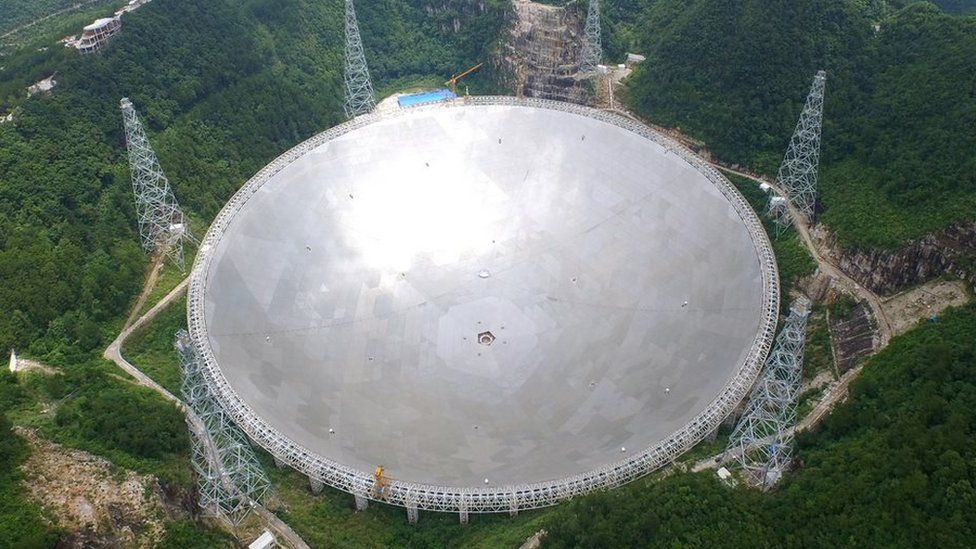China's colossal radio telescope begins testing
- Published

The world's largest radio telescope, which has been built in China, is beginning an intensive testing phase.
Chinese scientists report that the giant dish, which measures 500m (1,640ft) across, is complete and has received its first signals from space.
It will now take three years to calibrate the instrument so it can become fully operational.
The facility, part of China's drive to become a science powerhouse, was opened at a ceremony on Sunday.
"This is very exciting," Prof Peng Bo, deputy project manager of the Five Hundred Metre Aperture Spherical Telescope (Fast), told the BBC.
"For many years, we have had to go outside of China to make observations - and now we have the largest telescope. People can't wait to use it."
Rebecca Morelle takes a close up tour of China's new Five-hundred-metre Aperture Spherical Telescope - or Fast for short
The radio telescope, located in a vast natural crater in Guizhou Province in southwest China, has been an ambitious project for the National Astronomical Observatories of China.
With its 500m dish made up of thousands of triangular panels, it dwarfs the former record holder, the Arecibo Observatory in Puerto Rico with a diameter of 305m.
By comparison the Lovell telescope at Jodrell Bank in the north of England measures 76m across.
While China's telescope in its entirety is too big to move and be fully steerable, each of its triangular panels can be adjusted. It means the surface can be re-angled to allow scientists to study the parts of the sky they choose.
Despite the scale, construction took just five years and cost $180m (£140m).
Analysis - Rebecca Morelle, Global Science Correspondent
Earlier this year, I visited China's radio telescope to see the final stages of its construction.
It was truly mind-blowing in both its scale and its scientific ambition, and shows just how far China has come in its bid to become a global science powerhouse.
Just a few decades ago the nation barely ranked in the world science rankings. Now, in terms of research spending and the number of scientific papers published, it stands just behind the US.
With the telescope China enters into the next phase of its research renaissance - and the world is now watching to see if it can live up to its promise.
Find out more about China's Science Revolution in this special report.
The telescope works by "listening" for radio waves emitted by objects in space.
Because this structure is so big, it is able to collect signals from the far reaches of the cosmos.
After construction was complete, Prof Peng said the instrument was able to detect radio waves from three pulsars, which are rapidly rotating, extremely dense stars. They are a key scientific target for the team.
However, he said much more work needed to be done before the telescope could begin to work to its full potential. This will involve testing, tuning and calibrating it.
"Normally a traditional telescope will take about two years to become fully functional, but Fast is so big, I would say we need three years before it is open to the world," said Prof Peng.
However, he added that the team would be able to carry out some science in this testing phase, and would be working with international astronomers.
Prof Nan Rendong, who is the mastermind of the telescope and its chief scientist, said that collaboration with the global scientific community would be a vital part of the project.
"As soon as the telescope works normally, a committee will distribute observation time according to the scientific value of the proposals. Proposals from foreign scientists will be accepted and there will be foreign scientists on the allocation committee."
The telescope will eventually become a powerful tool for astronomers. Once fully operational, it could transform our understanding of the universe - to see the first stars and even look for signs of life.
Prof Simon Garrington, associate director for Jodrell Bank Observatory, said it was a major achievement for Chinese scientists.
"It's a hugely ambitious project, and it's been carried out very efficiently. It's probably come on stream faster than any of us would have expected for such a complex project."
He added that the telescope would be a "huge boost" to the world's network of telescopes.
Follow Rebecca on Twitter: @BBCMorelle
- Published4 July 2016
- Published16 February 2016
- Published23 May 2016